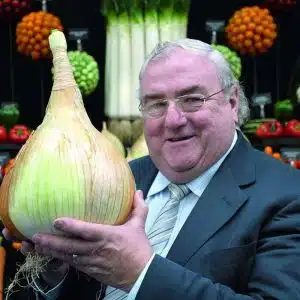Home - Backing up with an F1 Hybrid celery seed for the Chelsea Show. Transplanting young Onion Seedlings

Medwyn Williams
Hello. I'm Medwyn Williams – eleven times Gold medal winner at the Chelsea Flower Show, Past Chairman of the Royal Horticultural Society Fruit Vegetable and Herb Committee and President of the National Vegetable Society.
Backing up with an F1 Hybrid celery seed for the Chelsea Show. Transplanting young Onion Seedlings
Celery – there is nothing worse than having banked on a certain sowing only to find, for some reason or other, that the germination has been poor. Celery of course is the smallest of all vegetable seed and it can be tricky to germinate if you haven’t got the proper facilities for it. Young Onion Seedlings – time to transplant.
It’s been a fortnight now since I sowed a small pinch of my own F1 Hybrid celery seed for the Chelsea Show, this was primarily as a back up to my first sowing just before Christmas. There is nothing worse than having banked on a certain sowing only to find, for some reason or other, that the germination has been poor. Celery of course is the smallest of all vegetable seed and it can be tricky to germinate if you haven”t got the proper facilities for it. I intend to make another sowing this weekend which should cater for the mid to late August shows.
Having seen the phenomenal heads that both Chris Hewlett and his next door neighbour and friend Bob Brown had at the Malvern Show last September I have decided to sow Evening Star F1 and Redstar F1, the ones that did so well for them.
Seed Compost and Vermiculite
Ideally celery needs to be sown on the surface of some good quality seed compost and then very lightly covered over with a small amount of Vermiculite. The seed tray should then be placed in a propagator or on a propagating bench or heated blanket allowing plenty of bottom heat to warm up the compost and induce an even germination. It can take anything up to 3 weeks to germinate and it should be transplanted whilst still at the seedling leaf stage and just before the true rough leaf appears.
Beds
The beds were made during late October with plenty of organic farmyard manure incorporated which I think is a pre requisite for top quality celery heads. Chris was telling me that he has a source of manure so old that the farmer actually cuts through it, just like tobacco. Chris then takes this home and soaks it in a big bath before applying it liberally to all his trenches as a slurry – no wonder he gets such top quality heads. The one other good point to mention about the new celery hybrids is their ability, seemingly, to withstand the dreaded heart rot far better than Ideal. The other obvious plus point is it’s eating qualities, if they have been grown well, any of the five hybrids that I have, tastes as good, if not superior, to any self blanching variety. They are of course all crosses with the variety Ideal but each one has a different self blanching variety as a parent line.
Slugs
Celery appears to all exhibitors to be the slugs favourite meal, they seem, in my garden at least, to be able to ignore all other vegetation and crawl their way from everywhere in the garden to get at them. Don’t think that your greenhouse is a safe haven either, they can get in there too, so do make sure, particularly at the very young seedling stage, that you judiciously spread a few pellets around. My greenhouses are clean, but believe me it only takes the tiniest of slugs to devour a few young seedlings in one evening.
Young Onion Seedlings
Your young onions seedlings should by now be transplanted into whatever method that you use to keep them growing away. Multicell 40’s have been my main source to start off the seedlings in the past, but I have now reverted to 60 cells that fit into a full sized seed tray. (picture attached) This has certainly been an improvement as the plants are bolder and take up much less room in the greenhouse. As I have said before, watering from now on, right through to planting out, is paramount. Too little as well as too much can be a major problem which may well not become evident until they are planted up in their beds. Those that have suffered any extremes will inevitably show that through bolting, (throwing up a seed head prematurely). When this happens then you might as well remove all the bulbs as they will not be of any use to you on the show bench.
When they are in the young cells, it really is important to look at them twice a day, just to be sure that each and every cell has enough moisture in it to release the nutrients within that small space that the onion seedling requires to thrive on. Check them first thing in the morning before going to work as well as on your return in the evening. On some days you may well only need to water one or two cells and on other days you will have to be much more patient as a number of individual cells within a tray will require moisture. Use a tiny watering can or even an old teapot, another good idea is to use an old liquid soap bottle which is used for washing dishes. Obviously wash it out thoroughly and then fill it up with water from a tub in the greenhouse and just squeeze the right amount in each cell.
Watering and Studying Plants
I might well be going on at length about this watering bit which some growers find tedious, in fact I find it relaxing and it gives me the time to study the plants to make sure that they are growing away at their optimum. When the seedlings are at this young stage, it’s important to realise that they are growing in a nice warm cosy atmosphere, so make sure that any water you use is at that same temperature. I know for a fact how I would feel if I went in for a shower in my warm bathroom only to find it was on cold, it would certainly knock me back to say the least; think of your plants in that vain as well, they will most certainly reward you.
